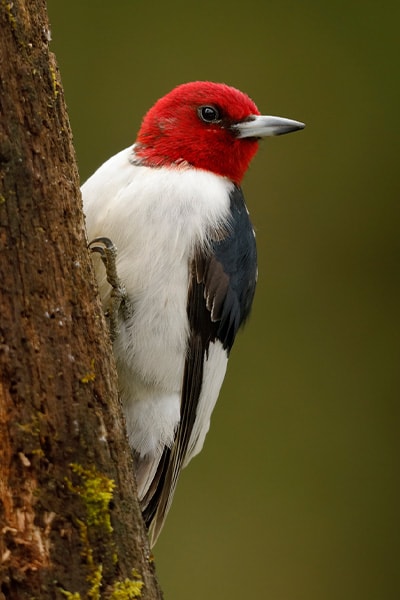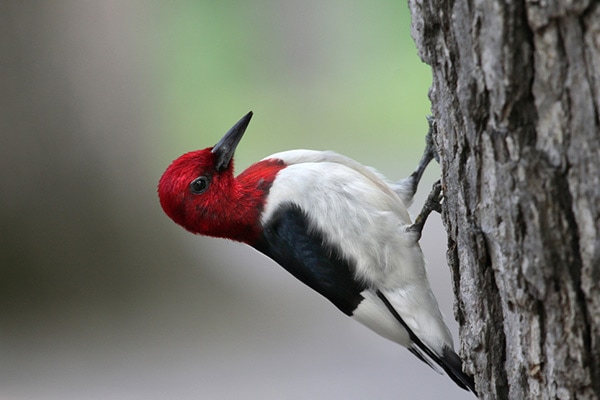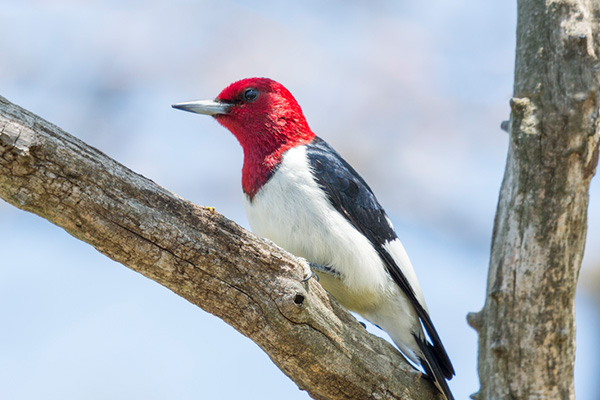Contents [show]
Red-headed woodpeckers also named a flying checkerboard, are birds known for their bold colored red heads, white bodies, blue-black backs, and half white, half black wings. Despite being named a woodpecker, they are only one of the very few North American woodpeckers that store food and even cover them.
In this article, we’re going to learn more about Red-headed Woodpeckers. We’ll discuss:
- How to identify them
- Where you’ll find them
- What they eat
- How they nest
- Their behaviors
- How to attract them
- Their conservation status
- Interesting facts
So if you want to learn more about these birds, read on as we go through all bird facts…

Red-headed woodpecker facts
- Common Name: Red-headed Woodpecker
- Scientific Name: Melanerpes erythrocephalus
- Scientific Family: Picidae
- Life Span: 9.9 years
- Size: 7.5 to 9.1 inches
- Wingspan: 16.5 inches
- Weight: 2.0 to 3.2 oz
- Conservation status: Near Threatened (NT)
Red-headed woodpecker: how-to identify
Red-headed woodpeckers are medium-sized woodpeckers that grow at 7.5 to 9.1 inches in length and weigh around 2.0 to 3.2 ounces.
As their name implies, these birds feature a bright red color on their entire head, neck, and throat. They also feature snowy white underparts, blue-black backs, black-colored tails, and half-white and half-black wings.
Unlike most woodpeckers who have very intricate patterns, red-headed woodpecker patterns are bold and clean, making them easily recognizable even from afar.
Differences Between Male & Female
Red-headed woodpeckers are known to be sexually monomorphic, which means male and female birds look exactly the same. They both have bright red heads, white bodies, and half-white and half-black tails.
Young birds also look very similar to adult birds with brown heads instead of red.
Differences In Summer Plumage vs Winter Plumage
Red-headed woodpeckers look the same throughout the year, no matter what the season is.
Where You’ll See Red-headed Woodpeckers
Red-headed woodpeckers are mostly seen in the eastern part of the United States, ranging west to east of North Dakota to Maine and going south to Florida and northern Texas.
These birds are mainly found breeding in deciduous woods where there are oak or beech trees. But they can also be very adaptable and seen breeding in areas with dead or dying trees, farmlands, grasslands, forest edges, orchards, burned areas, near bodies of water, and even roadsides.
These birds tend to live in the center of the forest, but move towards the edges when the breeding season starts. When winter arrives, they’ll opt to stay in mature trees, preferably oak, maple, ash, beech, pine, and even pine-oak.
Red-headed woodpecker bird migration
Red-headed woodpeckers are irregular short-distance or partial migratory birds, only leaving their habitats when there is a shortage of food. They are resident birds in some states, and birds in their northern or western ranges go south for winter.
These birds usually go where acorn or beech nuts are, sometimes wandering from their group and only moving during the daytime.
Red-headed woodpecker diet
Red-headed woodpeckers are omnivores and their diet is mainly composed of insects, spiders, nuts, berries, seeds, and fruits. They also feed on small mammals and eat young or eggs of other bird species, including bluebirds and house sparrows.
About one-third of these birds’ diet is made up of insects like beetles, honeybees, and grasshoppers. And unlike most woodpeckers, they are one of the best flycatchers and can even catch insects while they are still in the air.

Red-headed woodpecker nesting
- Clutch Size: 3-10 eggs
- # of Broods: 1-2 broods
- Incubation Period: 12-14 days
- Nestling Period: 24-31 days
- Egg Description: Pure white
Red-headed woodpeckers often nest in dead trees or dead parts of live trees found in fields or open forests. Male red-headed woodpeckers are the ones who will select their nesting site while the female birds are the ones who’ll decide if the site is good enough.
These birds would often choose trees that are smooth or have already lost most of their barks. But there are also times when they choose to excavate holes in live branches or even buildings. They don’t normally use natural cavities, and unlike most woodpeckers, they reuse their built cavities for years.
Both parents help each other to build their nests, but only the male birds do most of the excavation or digging which usually takes around 12-17 days to finish.
Red-headed woodpecker behavior
Red-headed woodpeckers are solitary birds, mainly staying in their own territories all year-round. They quickly pick fights with other bird species, even if it’s their own, and are mostly not afraid of any bird, even the bigger ones.
It is a proven fact that these birds are one of the most aggressive woodpeckers around. If other woodpeckers only chase away those who come to their territory, red-headed woodpeckers do more than that. They will fight head-on, and never back out.
These birds are strong fliers with the ability to catch insects even while on flight. They also have the ability to climb up tree trunks and limbs, often staying still in one area for long periods.
They spend most of their time foraging, and it has been observed that when nuts and insects are plenty, they store them for later consumption. This is a type of behavior that other woodpeckers don’t have, and they are only one of the very few North American woodpeckers that do this.
How-to attract red-headed woodpeckers
Red-headed woodpeckers typically visit bird feeders only in winter mainly for suet. But they also eat other food like seeds, corn, beechnuts, pecans, acorns, and fruits like berries.
With this in mind, it’s best to hang a suet feeder with suet filled with foods they love. You can also plant some fruit-bearing shrubs or trees around for these birds to enjoy.
If you want red-headed woodpeckers to stay around longer, you can keep dead trees around your property, but make sure that it’s safe. These will help call red-headed woodpeckers to nest on your property.
It also helps to have deciduous trees around for nesting and foraging.
Red-headed woodpecker threats
Red-headed Woodpeckers are found to be continuously declining. In fact, their population has declined by 70% from 1966 to 2014, making them part of the 2014 State of Birds Watch List and also the IUCN Red List.
Around 100 red-headed woodpeckers were shot down every day in the 19th century. This is one of the biggest reasons for the birds’ decline. Added to that, many nut-producing trees have been cut down, leaving these birds with very little food to eat.
These birds are also vulnerable to predation. Among their known predators are Cooper’s hawks, peregrine falcons, eastern screech-owls, red foxes, black rat snakes, raccoons, and flying squirrels.
Red-headed woodpecker fun & interesting facts
- Red-headed Woodpeckers are also called flying checkerboard, half-a-shirt, shirt-tail bird, jellycoat, and flag bird.
- They are one of the most skillful flycatchers among the North American woodpecker species.
- The only North American woodpecker that stores food and covers it with bark.
- Used by Cherokee Indians as a symbol in war.
- They are fierce defenders of their territory.
- It is the bird that sparked the interest of legendary ornithologist Alexander Wilson to study birds in the 1700s.
- The oldest recorded Red-headed Woodpecker lived for 9 years and 11 months.
- Williamson’s Sapsucker
- Yellow-bellied Sapsucker
- Red-naped Sapsucker
- Red-breasted Sapsucker
- Lewis’s Woodpecker
- Acron Woodpecker
- Gila Woodpecker
- Golden-fronted Woodpecker
- Red-bellied Woodpecker
- American Three-toed Woodpecker
- Black-beaded Woodpecker
- Downy Woodpecker
- Nuttall’s Woodpecker
- Ladder-backed Woodpecker
- Red-cockaded Woodpecker
- Hairy Woodpecker
- White-headed Woodpecker
- Arizona Woodpecker
- Ivory-billed Woodpecker
- Pileated Woodpecker
- Northern Flicker
- Gilded Flicker

